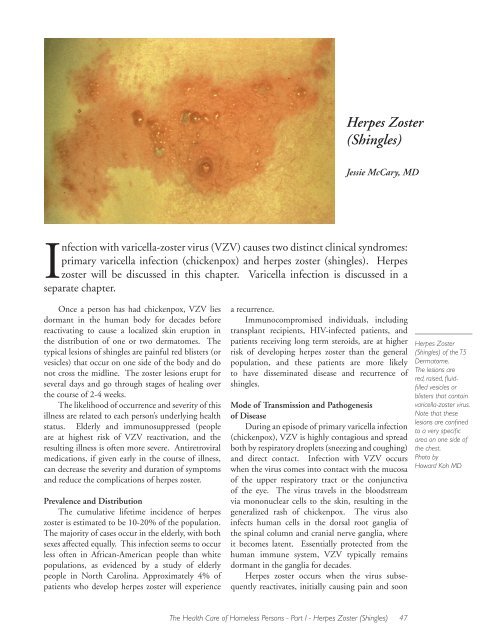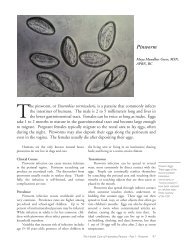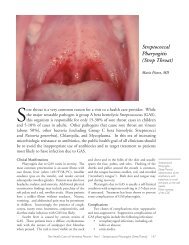Herpes Zoster (Shingles) - Boston Health Care for the Homeless
Herpes Zoster (Shingles) - Boston Health Care for the Homeless
Herpes Zoster (Shingles) - Boston Health Care for the Homeless
Create successful ePaper yourself
Turn your PDF publications into a flip-book with our unique Google optimized e-Paper software.
<strong>Herpes</strong> <strong>Zoster</strong><br />
(<strong>Shingles</strong>)<br />
Jessie McCary, MD<br />
Infection with varicella-zoster virus (VZV) causes two distinct clinical syndromes:<br />
primary varicella infection (chickenpox) and herpes zoster (shingles). <strong>Herpes</strong><br />
zoster will be discussed in this chapter. Varicella infection is discussed in a<br />
separate chapter.<br />
Once a person has had chickenpox, VZV lies<br />
dormant in <strong>the</strong> human body <strong>for</strong> decades be<strong>for</strong>e<br />
reactivating to cause a localized skin eruption in<br />
<strong>the</strong> distribution of one or two dermatomes. The<br />
typical lesions of shingles are painful red blisters (or<br />
vesicles) that occur on one side of <strong>the</strong> body and do<br />
not cross <strong>the</strong> midline. The zoster lesions erupt <strong>for</strong><br />
several days and go through stages of healing over<br />
<strong>the</strong> course of 2-4 weeks.<br />
The likelihood of occurrence and severity of this<br />
illness are related to each person’s underlying health<br />
status. Elderly and immunosuppressed (people<br />
are at highest risk of VZV reactivation, and <strong>the</strong><br />
resulting illness is often more severe. Antiretroviral<br />
medications, if given early in <strong>the</strong> course of illness,<br />
can decrease <strong>the</strong> severity and duration of symptoms<br />
and reduce <strong>the</strong> complications of herpes zoster.<br />
Prevalence and Distribution<br />
The cumulative lifetime incidence of herpes<br />
zoster is estimated to be 10-20% of <strong>the</strong> population.<br />
The majority of cases occur in <strong>the</strong> elderly, with both<br />
sexes affected equally. This infection seems to occur<br />
less often in African-American people than white<br />
populations, as evidenced by a study of elderly<br />
people in North Carolina. Approximately 4% of<br />
patients who develop herpes zoster will experience<br />
a recurrence.<br />
Immunocompromised individuals, including<br />
transplant recipients, HIV-infected patients, and<br />
patients receiving long term steroids, are at higher<br />
risk of developing herpes zoster than <strong>the</strong> general<br />
population, and <strong>the</strong>se patients are more likely<br />
to have disseminated disease and recurrence of<br />
shingles.<br />
Mode of Transmission and Pathogenesis<br />
of Disease<br />
During an episode of primary varicella infection<br />
(chickenpox), VZV is highly contagious and spread<br />
both by respiratory droplets (sneezing and coughing)<br />
and direct contact. Infection with VZV occurs<br />
when <strong>the</strong> virus comes into contact with <strong>the</strong> mucosa<br />
of <strong>the</strong> upper respiratory tract or <strong>the</strong> conjunctiva<br />
of <strong>the</strong> eye. The virus travels in <strong>the</strong> bloodstream<br />
via mononuclear cells to <strong>the</strong> skin, resulting in <strong>the</strong><br />
generalized rash of chickenpox. The virus also<br />
infects human cells in <strong>the</strong> dorsal root ganglia of<br />
<strong>the</strong> spinal column and cranial nerve ganglia, where<br />
it becomes latent. Essentially protected from <strong>the</strong><br />
human immune system, VZV typically remains<br />
dormant in <strong>the</strong> ganglia <strong>for</strong> decades.<br />
<strong>Herpes</strong> zoster occurs when <strong>the</strong> virus subsequently<br />
reactivates, initially causing pain and soon<br />
<strong>Herpes</strong> <strong>Zoster</strong><br />
(<strong>Shingles</strong>) of <strong>the</strong> T5<br />
Dermatome.<br />
The lesions are<br />
red, raised, fluidfilled<br />
vesicles or<br />
blisters that contain<br />
varicella-zoster virus.<br />
Note that <strong>the</strong>se<br />
lesions are confined<br />
to a very specific<br />
area on one side of<br />
<strong>the</strong> chest.<br />
Photo by<br />
Howard Koh MD<br />
The <strong>Health</strong> <strong>Care</strong> of <strong>Homeless</strong> Persons - Part I - <strong>Herpes</strong> <strong>Zoster</strong> (<strong>Shingles</strong>) 47
Dermatomes.<br />
A dermatome is a<br />
segmental area of<br />
<strong>the</strong> skin innervated<br />
by fibers from a<br />
single dorsal<br />
nerve root of <strong>the</strong><br />
spinal cord.<br />
Helpful hints:<br />
C6 (thumb),<br />
T10 (umbilicus),<br />
L5 (top of foot),<br />
S1 (bottom of foot).<br />
Courtesy of MGH<br />
afterwards a vesicular rash in <strong>the</strong> distribution of one<br />
or two contiguous dermatomes. <strong>Herpes</strong> zoster is less<br />
contagious than varicella. <strong>Zoster</strong> generally spreads<br />
only by direct contact with open, draining lesions<br />
and not via airborne droplets. This fragile virus<br />
can live <strong>for</strong> short periods of time on fomites such<br />
as towels, linens, and clo<strong>the</strong>s. These items must be<br />
viewed as potential sources of transmission. Once<br />
48 The <strong>Health</strong> <strong>Care</strong> of <strong>Homeless</strong> Persons - Part I - <strong>Herpes</strong> <strong>Zoster</strong> (<strong>Shingles</strong>)
<strong>the</strong> lesions of shingles have crusted over and are no<br />
longer draining, <strong>the</strong> patient is no longer infectious.<br />
Remember that a person with shingles cannot<br />
transmit zoster or shingles to o<strong>the</strong>rs. However,<br />
contact with drainage from zoster lesions can cause<br />
chickenpox in individuals who have no history<br />
of prior varicella infection and have never had<br />
chickenpox.<br />
Immunocompromised patients with zoster are<br />
at risk of developing widespread infection with VZV,<br />
called disseminated herpes zoster. This potentially<br />
serious illness may result in skin lesions over <strong>the</strong><br />
entire body and infection of internal organs. This<br />
infection is thought to be more contagious than<br />
typical herpes zoster and may be spread by airborne<br />
droplets, as in primary varicella infection. For this<br />
reason, any patient with disseminated zoster, as well<br />
as those at risk <strong>for</strong> this infection, should be hospitalized<br />
with strict respiratory isolation.<br />
Symptoms and Diagnosis<br />
A prodrome of fever, malaise, and headache<br />
often precedes <strong>the</strong> vesicular eruption. Many patients<br />
experience pain and dyses<strong>the</strong>sias in <strong>the</strong> distribution<br />
of a sensory dermatome several days or weeks be<strong>for</strong>e<br />
<strong>the</strong> rash appears.<br />
In immunocompetent individuals, <strong>the</strong> typical<br />
rash begins with groups of fluid-filled vesicles on a<br />
red or ery<strong>the</strong>matous base. These are on one side of<br />
<strong>the</strong> body and limited to one or two dermatomes.<br />
The most commonly involved dermatomes are<br />
those innervated by <strong>the</strong> thoracic and lumbar nerves,<br />
and <strong>the</strong> ophthalmic branch of <strong>the</strong> trigeminal nerve.<br />
Crusting of <strong>the</strong> lesions usually occurs within ten<br />
days but may take as long as one month.<br />
The diagnosis of herpes zoster is made clinically<br />
by <strong>the</strong> history of <strong>the</strong> prodrome, often with localized<br />
pain, and followed by <strong>the</strong> typical rash. <strong>Shingles</strong><br />
can usually be differentiated from chickenpox and<br />
herpes simplex on <strong>the</strong> basis of <strong>the</strong>se characteristic<br />
symptoms and findings. Laboratory confirmation<br />
is necessary only in cases in which an atypical rash<br />
renders <strong>the</strong> diagnosis uncertain. Vesicular fluid can<br />
be examined by Tzanck smear, culture, polymerase<br />
chain reaction, or fluorescence microscopy.<br />
Treatment<br />
The goal of treatment of acute herpes zoster<br />
is to accelerate <strong>the</strong> healing of painful lesions and<br />
to prevent complications such as those mentioned<br />
in <strong>the</strong> next section. Many studies have examined<br />
<strong>the</strong> effects of antiviral <strong>the</strong>rapy with acyclovir (Zovirax<br />
TM ), valacyclovir (Valtrex TM ), and famciclovir<br />
(Famvir TM ), all three of which are FDA-approved<br />
<strong>for</strong> <strong>the</strong> treatment of herpes zoster infection. The<br />
use of oral steroids in combination with antiviral<br />
<strong>the</strong>rapy has also been studied. The evidence that<br />
any of <strong>the</strong>se <strong>the</strong>rapies is effective in preventing<br />
complications is limited, and no <strong>for</strong>mal consensus<br />
<strong>for</strong> <strong>the</strong> use of <strong>the</strong>se agents exists.<br />
An acceptable approach is to withhold antiviral<br />
<strong>the</strong>rapy from healthy adults under <strong>the</strong> age of 50<br />
unless <strong>the</strong>re is ophthalmic involvement or severe<br />
pain. Patients over <strong>the</strong> age of 50 should be treated<br />
with an antiviral agent. Antiviral agents are more<br />
effective if begun within 72 hours of <strong>the</strong> onset of<br />
symptoms. Some clinicians consider initiating<br />
<strong>the</strong>rapy after this 72 hour window if new skin<br />
lesions continue to emerge. The mainstay of<br />
antiviral <strong>the</strong>rapy <strong>for</strong> normal adults has been a 7-10<br />
day course of acyclovir (Zovirax TM ) 800 mg PO<br />
five times per day. Valacyclovir (Valtrex TM ) 1000<br />
mg PO TID and famciclovir (Famvir TM ) 500 mg<br />
PO TID have simpler dosing regimens and may be<br />
preferred <strong>for</strong> this reason.<br />
Oral antiretrovirals are also effective in HIV<br />
positive patients with localized zoster infection.<br />
Because of <strong>the</strong> increased risk of relapse, treatment<br />
(left) Multinucleated<br />
Giant Cell.<br />
This Tzanck smear<br />
is from a scraping<br />
from <strong>the</strong> base of an<br />
unroofed blister. This<br />
microscopic finding<br />
of a multinucleated<br />
giant cell indicates<br />
<strong>the</strong> presence of a<br />
virus of <strong>the</strong> herpes<br />
family.<br />
(right)<br />
<strong>Herpes</strong> <strong>Zoster</strong><br />
(<strong>Shingles</strong>) of <strong>the</strong><br />
T11-T12<br />
Dermatomes.<br />
Several of <strong>the</strong><br />
blisters have become<br />
crusted. Severe<br />
pain commonly<br />
accompanies this<br />
infection. Note that<br />
<strong>the</strong>se lesions do not<br />
cross <strong>the</strong> mid-line.<br />
Photos by<br />
Howard Koh MD<br />
The <strong>Health</strong> <strong>Care</strong> of <strong>Homeless</strong> Persons - Part I - <strong>Herpes</strong> <strong>Zoster</strong> (<strong>Shingles</strong>) 49
should continue until all lesions have completely<br />
resolved. If dissemination occurs, intravenous<br />
<strong>the</strong>rapy is indicated.<br />
The addition of steroids to an antiviral regimen<br />
has not been proven to prevent post herpetic<br />
neuralgia, but should be considered in patients with<br />
severe pain in order to reduce <strong>the</strong> duration of acute<br />
symptoms. Steroids should not be used in patients<br />
with relative contraindications such as diabetes<br />
mellitus, gastritis, osteoporosis, or glaucoma.<br />
Amitriptyline (Elavil TM ), a tricyclic antidepressant<br />
that has also been used to treat neuropathic<br />
pain, may decrease <strong>the</strong> risk of post herpetic<br />
neuralgia. A dose of 25 mg nightly, started within a<br />
couple days of <strong>the</strong> onset of <strong>the</strong> rash and continued<br />
<strong>for</strong> 90 days, has not been widely studied.<br />
Pain control is a very important aspect in <strong>the</strong><br />
treatment of this illness as well as zoster’s most<br />
common complication, post herpetic neuralgia.<br />
Potential treatments to control pain include<br />
capsaicin ointment (Zostrix TM ), tricyclic antidepressants,<br />
gabapentin (Neurontin TM ), topical lidocaine,<br />
narcotics, and even regional nerve blocks.<br />
Complications<br />
Post herpetic neuralgia is <strong>the</strong> most common<br />
complication of herpes zoster, occurring in 10-15<br />
percent of all patients. The risk of this complication<br />
increases with age. Post herpetic neuralgia is defined<br />
as sensory symptoms (usually pain or numbness)<br />
that exist in <strong>the</strong> distribution of <strong>the</strong> previously<br />
involved dermatome more than 30 days after <strong>the</strong><br />
initial rash.<br />
<strong>Herpes</strong> zoster ophthalmicus is ano<strong>the</strong>r<br />
common complication. <strong>Care</strong>givers should be aware<br />
that involvement of <strong>the</strong> ophthalmic branch of <strong>the</strong><br />
trigeminal nerve is potentially sight-threatening.<br />
Evidence of this complication may include<br />
unilateral eye pain, vesicular eruption around <strong>the</strong><br />
eye, conjunctivitis, episcleritis, iritis, or lid droop.<br />
Referral to an ophthalmologist must be made<br />
immediately.<br />
<strong>Health</strong> care providers should monitor patients<br />
<strong>for</strong> signs of bacterial superinfection of skin lesions,<br />
which may require antibiotic <strong>the</strong>rapy. Change in<br />
mental status, spread of skin lesions beyond two<br />
dermatomes, or involvement of <strong>the</strong> eyes should<br />
prompt immediate referral to specialists.<br />
Prevention and Control<br />
<strong>Herpes</strong> zoster is not as contagious as primary<br />
varicella infection (chickenpox). People who have<br />
had chickenpox in <strong>the</strong> past are considered immune<br />
and are not at risk of developing shingles or chickenpox<br />
if exposed to a patient with shingles.<br />
Persons who have never had primary varicella<br />
infection are at risk of developing chickenpox if <strong>the</strong>y<br />
are exposed directly to <strong>the</strong> draining vesicles of shingles.<br />
For this reason, several precautions should be<br />
taken to decrease <strong>the</strong> risk to non-immune persons.<br />
<strong>Care</strong>givers should wear gloves when examining <strong>the</strong><br />
patient. Draining vesicles should be covered with<br />
a dressing until <strong>the</strong>y have crusted over. Fomites,<br />
such as linens and clo<strong>the</strong>s, may harbor <strong>the</strong> virus and<br />
should be handled with gloves. Once crusting of <strong>the</strong><br />
vesicles occurs, <strong>the</strong>re is no longer a risk of infectivity.<br />
If <strong>the</strong>se precautions are taken, <strong>the</strong> risk to o<strong>the</strong>rs in a<br />
shelter is minimal.<br />
Pregnant women who are susceptible to VZV<br />
(have never had chickenpox) and are exposed to a<br />
patient with shingles should be referred <strong>for</strong> administration<br />
of varicella zoster immune globulin (VZIG)<br />
to decrease potential risk to <strong>the</strong> fetus.<br />
Immunocompromised patients with herpes<br />
zoster are at high risk of developing disseminated<br />
disease, in which airborne spread is possible in addition<br />
to direct contact. There<strong>for</strong>e, hospitalization<br />
and respiratory isolation should be considered in<br />
immunocompromised patients with localized or<br />
disseminated zoster.<br />
Varicella vaccine is a live, attenuated vaccine<br />
against VZV that was licensed in 1995. It is<br />
contraindicated during pregnancy and is currently<br />
not recommended in HIV-infected individuals,<br />
although its safety in this population is under<br />
evaluation. Vaccination against VZV is currently<br />
recommended <strong>for</strong> <strong>the</strong> following susceptible adults<br />
(without a reliable history of chickenpox or a serologic<br />
test indicating immunity): health care workers,<br />
those with close contact to immunocompromised<br />
individuals or young children, and women who<br />
could become pregnant.<br />
Special Consideratons <strong>for</strong> <strong>Homeless</strong> Populations<br />
While not proven by research studies at this<br />
time, psychological stress may be a risk factor <strong>for</strong><br />
<strong>the</strong> development of herpes zoster. Although <strong>the</strong><br />
prevalence of herpes zoster in homeless populations<br />
has not been specifically determined, <strong>the</strong> profound<br />
psychological stresses of homelessness may be<br />
associated with an increased risk of this condition in<br />
homeless persons, especially <strong>the</strong> elderly.<br />
Summary<br />
<strong>Herpes</strong> zoster results from reactivation of VZV,<br />
<strong>the</strong> same virus that causes chickenpox. The illness<br />
50 The <strong>Health</strong> <strong>Care</strong> of <strong>Homeless</strong> Persons - Part I - <strong>Herpes</strong> <strong>Zoster</strong> (<strong>Shingles</strong>)
is generally less severe than chickenpox, with painful<br />
skin lesions that are typically limited to one or two<br />
dermatomes.<br />
Early treatment of localized zoster infection<br />
with antiretroviral medication is indicated in<br />
patients over <strong>the</strong> age of 50 or any patient with<br />
ei<strong>the</strong>r ophthalmologic involvement or severe pain.<br />
Steroids, in addition to anti-retrovirals, may decrease<br />
<strong>the</strong> severity and duration of pain. Analgesia is an<br />
important aspect in <strong>the</strong> treatment of this painful<br />
infection.<br />
Serious complications may arise from herpes<br />
zoster, including disseminated disease, ophthalmologic<br />
involvement, and infection of various<br />
organs. Immunocompromised individuals are at<br />
particular risk of complications. Immediate referral<br />
to infectious disease specialists is indicated in <strong>the</strong>se<br />
situations.<br />
Patients with herpes zoster can transmit VZV to<br />
o<strong>the</strong>rs via direct contact with draining skin lesions.<br />
Only people who have never had chickenpox are at<br />
risk, and <strong>the</strong> resulting illness is primary varicella<br />
infection (chickenpox). This risk becomes minimal<br />
in shelters if skin lesions are covered with dressings<br />
and gloves are worn when clo<strong>the</strong>s and linens are<br />
handled. E<br />
The author of this chapter gratefully acknowledges<br />
<strong>the</strong> invaluable contribution of Janet Groth, RN, MS,<br />
who authored this chapter in <strong>the</strong> original Manual.<br />
<strong>Herpes</strong> <strong>Zoster</strong> Medication List<br />
Generic Brand Name Cost<br />
acyclovir Zovirax $<br />
amitryptyline Elavil $<br />
capsaicin Zostrix $<br />
famciclovir Famvir $$$<br />
gabapentin Neurontin $$$$$<br />
valacyclovir Valtrex $$$$<br />
References<br />
Albrecht MA. Clinical features of varicella-zoster infection: herpes zoster. UpToDate; 2002. http://uptodate.com<br />
Abrecht MA. Treatment and prevention of herpes zoster. UpToDate; 2002. http://www.uptodate.com<br />
Alper BS, Lewis PR. Does treatment of acute herpes zoster prevent or shorten pos<strong>the</strong>rpetic neuralgia? Journal of<br />
Family Practice 2000;49(3):255-264.<br />
Buchbinder SP, Katz MH, Hessol NA, et al. <strong>Herpes</strong> zoster and human immunodeficiency virus infection. Journal of<br />
Infectious Diseases 1992;166(5):1153-1156.<br />
Cohen JI, Brunell PA, Straus SE, et al. Recent advances in varicella-zoster virus infection. Annals of Internal Medicine<br />
1999;130(11):922-932.<br />
Glesby M, Moore RD, Chaisson RE. Clinical spectrum of herpes zoster in adults infected with human immunodeficiency<br />
virus. Clinical Infectious Diseases 1995;21(2):370-375.<br />
Gnann JW, Whitley RJ. Clinical practice. <strong>Herpes</strong> zoster. New England Journal of Medicine 2002;347(5):340-346.<br />
Straus SE, Ostrove JM, Inchauspe G, et al. Varicella-zoster virus infections. Biology, natural history, treatment, and<br />
prevention. Annals of Internal Medicine 1988;108(2):221-237.<br />
The <strong>Health</strong> <strong>Care</strong> of <strong>Homeless</strong> Persons - Part I - <strong>Herpes</strong> <strong>Zoster</strong> (<strong>Shingles</strong>) 51







